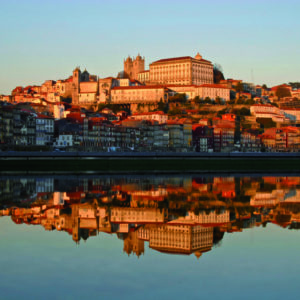Video courtesy of Visit Portugal Tourism
Portugal is situated on the western extremity of the Iberian Peninsula and has existed within unchanged borders for nearly 800 years. For a small country, it is diverse; from the sandy coves and colourful fishing villages to the manicured golf links of the southern Algarve. Less explored are the fertile flat plains where horses and fighting bulls graze, cylindrical brick windmills dot coastal hillsides, and the upper reaches of the Douro Valley produce Portugal’s famous product – port wine – from steeply terraced vineyards.
Later, as Lisbon flourished as a centre for trade under 300 years of Moorish rule, the Alfama section of the city hosted the Moorish aristocracy. Dom Alfonso III completed the Moorish expulsion in the Algarve, however, and made Lisbon the capital of the Kingdom of Portugal in 1255. Toward the end of the 15th century, Portuguese mariners developed advanced navigation techniques that permitted them to pioneer the exploration and charting of the “New World”.
Today, the city has three major quarters; the lower town is the heart of Lisbon where most of the governmental buildings and institutions are found. Barrio Alto, the upper town, is a charming area where time doesn’t seem to have meaning. The oldest part of Lisbon, the Alfama, is made up of tiny whitewashed houses along a labyrinth of narrow alleys.
Belem, formerly a separate town and now absorbed by Lisbon, contains the city’s masterpiece of Manueline architecture, the Monastery of Jeronimos Abbey. It stands in silent tribute to Portugal’s celebrated age of discoveries. It is a fine example of Manueline architecture, born out of an exuberant period when Portuguese navigators were leading the world in exploration.
St. George’s Castle stands magnificently atop one of Lisbon’s seven hills, with the city laid out before it. The breath-taking view from St. George’s shows terracotta tiled roofs, ancient monuments, as the Tagus River flows under its graceful suspension bridge.
Porto is the second largest city of Portugal, and the one from which the country derives its name. It sits on the Douro River, the most important in northern Portugal, and is a seaport city to this day. Hidden within not only the Old Quarter and throughout the city are gems to admire and enjoy. For example, there are the three bridges spanning the Douro including the Maria Pia, the railroad bridge designed by Eiffel. The two-tiered Ponte de Dom Luis connects Porto with Vila Nova de Gaia, home of the port wine trade. There are many antique shops, lively bars and a main shopping area.
The region is crossed by the River Douro which enters Portugal between the ravines and mountains of the interior to flow through the entire World Heritage landscape where the Port and Douro wines are produced. It is from here that the wine is sent to the lodges at Vila Nova de Gaia, as the cruises touring the region make their way upriver.
In this area of mountains and natural parks, the region’s heritage is seen in its castles, such as the one in Guimarães, and the shrines and churches which are the stage for pilgrimages in the summer. You will find the Baroque architecture of Northern Portugal in its stone and gilded carvings side by side with rural chapels. In its cities, which retain a human scale, such as Viana do Castelo, Braga, Lamego, Chaves and Vila Real, and in the manor houses and stately halls, you will find the genuine Portuguese people, who like to share their table, their customs and traditions. In Porto and Northern Portugal, the joy and gratitude for all we have and are is experienced in the most spontaneous way.
The flat land makes hiking and cycling easy, though horses are also part of the landscape. You can combine these rides with birdwatching and, in dams such as Alqueva, with the tranquillity of the waters or stargazing.
also explore the coast. The landscape here is hilly and rugged, with small sheltered coves between the cliffs, many of which are ideal for surfing. You will also breathe the scents of the countryside here, the aromatic herbs that season the fish, seafood and other regional fare to be accompanied by the region’s excellent wines. Indeed, the entire Alentejo lives according to the rhythm of the earth.
More cosmopolitan Portimão and Albufeira are bustling towns by night and day. Tavira is a showcase for traditional architecture and Faro, the gateway to the region, deserves a long stop to discover its beautiful historic centre.
To relax, you can have various treatments in the spas and thalassotherapy centres and in the Monchique Thermal Baths. There are also many internationally acclaimed golf courses where you can enjoy a spot of exercise. And hotels, tourist villages, resorts, from the simplest to the most sophisticated.
July is the hottest month in Lisbon with an average temperature of 24°C (74°F) and the coldest is January at 11°C (52°F) with the most daily sunshine hours at 11 in July. The wettest month is November with an average of 127.6mm of rain.
Showing the single result
Need Assistance?
800-227-5317 | sales@pacific-destinations.com
Tell us where and when you want to go and we’ll give your request our immediate attention! No high pressure sales, just straight talk and sound advice!

